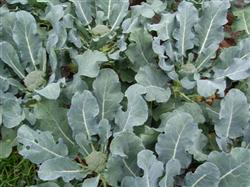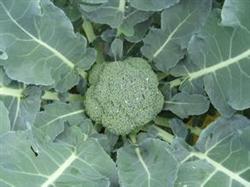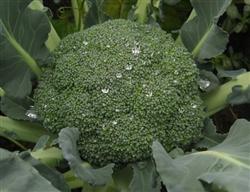Five keys to the cultivation of broccoli in spring open field

Broccoli grown in the open field in spring is in the season of higher temperature and heavier diseases and insect pests. As long as we grasp the five key points in cultivation, we can realize high yield and high efficiency, and meet the requirements of foreign businessmen. 1. Seeding at the right time. Spring open field cauliflower available resistance, high temperature resistance, compact and neat ball black green, Tokyo green and other varieties. In the middle and lower reaches of the Yangtze River, seeds are sown in small arched sheds from late March to early April. About 15 grams of seeds are used per mu. The seedbed is 7-8 square meters. After sowing, the cover is 1 cm thick and the fine soil is sieved. Water is sprinkled once a day. The seedlings grow 2-3 leaves once, and the seedlings grow 5-6 leaves before transplanting. 2. Planting at appropriate age. When planting, the seedling age is selected to be 25-30 days, 5-6 true leaves, thick stems, developed roots, no disease and insect pests are planted, sufficient root water is poured, and the next morning, the living tree water is poured again. The plant spacing is 40-45×50 cm, and about 300 plants are planted per mu. Three, three fat three water three catch. 10 kg urea was applied as seedling fertilizer in about 10 days after planting, 20 kg compound fertilizer was applied in about 20 days after planting, and 15 kg urea was applied as bud fertilizer after bud emergence. At the same time, spraying 0.3% borax 0.05-0.1% ammonium cuprate twice. After harvesting the lateral flower bulb, the main flower bulb is fertilized and watered to promote the development of the lateral flower bulb. Three waters. One is to irrigate enough root water; the other is to irrigate 1000kg of manure for green seedling water in 4-5 days; the third is to promote bud water. When the main flower ball grows to 3-6 cm, water it in time, irrigate most of the ditch water, drain the ridge surface after wetting, and in case of rainy weather, clear the ditch in time to achieve two stops of field dryness. Three catches. One is to do a good job of cultivating soil, 3-4 days of cultivation in slow seedling water, and the second and third cultivation are properly cultivated; the second is to grasp the bud, only harvest the main flower ball, and wipe off the early lateral branches by hand; the third is to grasp the pruning, harvest 4-5 lateral branches of the lateral branches, and knock off the rest of the lateral branches. 4. Prevention of three diseases and two insects. The three diseases and two insects are black spot, downy mildew, black rot, diamondback moth and cabbage caterpillar. Black rot disease can be controlled by 600-1000 times solution of 3% polyoxygen solution or 1200-1500 times solution of 4% agricultural antibiotic 120 solution, black rot disease can be controlled by 200 mg/kg of 72% agricultural streptomycin plus 10% calcium superphosphate extract or 100 mg/kg of neophytin, downy mildew can be controlled by 600-800 times solution of Terek or Lutaibao. To prevent cabbage caterpillar and diamondback moth, 800-1500 times solution of B type virus of "insect pest No.1" can be used for prevention and control, or 100-150 g of Bacillus borers mixed with 30-50 kg of water can be used for prevention and control. 5. Harvest. Broccoli harvest time is short, must be timely harvest. Harvesting criteria: bulb fully grown, green color, spherical slightly concave, bud tight, bulb solid. Harvesting too early, flower bulbs do not fully grow low yield, otherwise the flower bulbs will be yellow loose, low quality. It should be harvested after the dew dries in the morning. Corm base with young flower stems 7 cm, lateral corm with young flower stems 7-10 cm obliquely cut with knife. Broccoli is not resistant to storage and transportation, timely packaging or sales after harvest, and shock and pressure protection during transportation.
- Prev

Efficient cultivation of zucchini and cauliflower in greenhouse
Zucchini seedlings were raised with Zaoqing first generation variety. Raise seedlings in a nutrition bowl in the greenhouse, using 300 grams of seeds per mu. Soak seeds and accelerate germination to dew and sow seeds, 1 seed per bowl, cover 1.5 cm thick loose nutrient soil, cover with plastic film. Raise the temperature as much as possible before emergence and keep it at 30: 33 ℃ during the day. Cool down properly after finishing the seedling, during the day.
- Next

Key points of cultivation techniques of open field broccoli in spring
When broccoli is planted in open field in spring, its growth and development is in the season when the temperature is getting higher and the diseases and insect pests are becoming more and more serious. However, in cultivation, as long as we grasp the following five key technologies, we can achieve high yield and high efficiency, and meet the market demand. 1. Sow seeds at the right time. Planting cauliflower in open field in spring can be resistant to disease and high temperature.
Related
- Where is it suitable to grow horseradish in China? it is expected to see the middle altitude horseradish in Alishan.
- How to prevent tomato virus disease reasonably? (Control methods included)
- Many people like to plant towel gourd on the balcony. What are the main points of this method and management?
- What crops can chili peppers be mixed with?
- Fertilization techniques and matters needing attention in Tomato
- What are the grafting techniques for peach seedlings in spring?
- Harm and control methods of root swelling disease of Chinese cabbage
- What are the pests of sweet potatoes? How to prevent and cure it?
- Symptoms, causes and Control methods of navel Rot in Tomato
- The cause of "Cucumber rotten bibcock" in Farmers' planting Cucumber and its Control Plan

